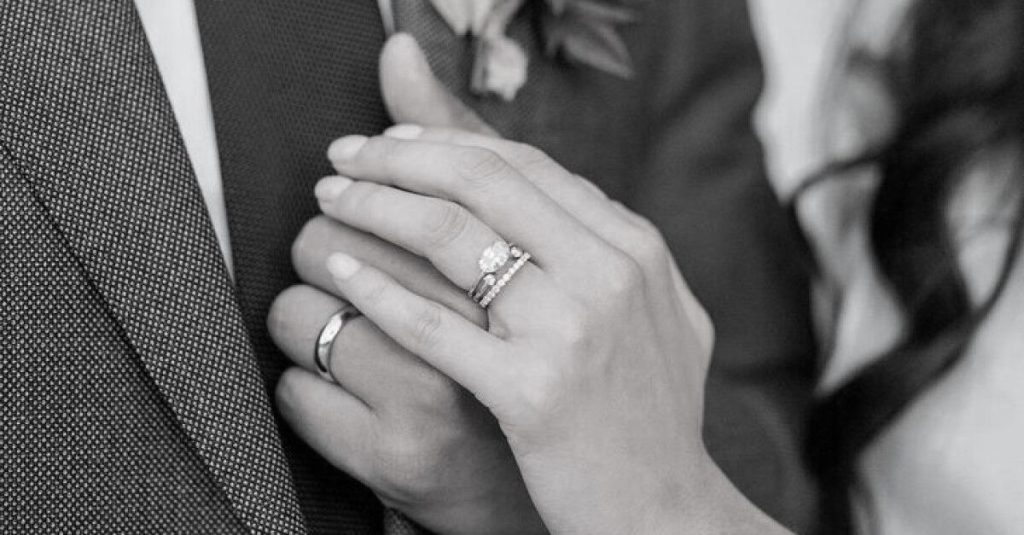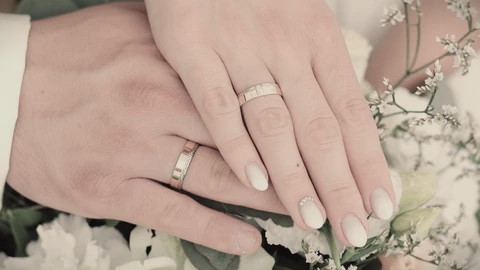Wedding Ring on Right Hand: Meaning, Traditions, and Symbolism
Wedding Ring on Right Hand. When most people think about wedding rings, they imagine a ring placed on the left hand — specifically on the fourth finger, known as the “ring finger.” However, in many cultures around the world, people wear their wedding ring on the right hand instead. This tradition carries deep historical, cultural, and even personal meanings.
Whether you’ve noticed someone wearing their wedding ring on the right hand or you’re considering doing it yourself, understanding the history and symbolism behind this practice can be fascinating. Let’s explore what it means, why it’s done, and where this tradition comes from. Wedding Ring on Right Hand
The History Behind Wearing a Wedding Ring on the Right Hand
The idea of wearing wedding rings dates back thousands of years. Ancient Egyptians, Greeks, and Romans all used rings to symbolize eternal love and commitment. The circular shape of the ring represented infinity — a bond with no beginning and no end. Wedding Ring on Right Hand
The left-hand tradition became popular in Western cultures due to an ancient Roman belief in the “vena amoris”, or “vein of love,” which was thought to run directly from the fourth finger of the left hand to the heart. While this romantic notion isn’t anatomically accurate, it established the left hand as the traditional choice for wedding bands in many countries. Wedding Ring on Right Hand
However, not every culture shared that belief. In some regions, the right hand was seen as a symbol of strength, honor, and virtue. As a result, wearing a wedding ring on the right hand became a tradition that represented loyalty and integrity — values at the core of marriage. Wedding Ring on Right Hand
Countries Where the Wedding Ring Is Worn on the Right Hand
The custom of wearing a wedding ring on the right hand is more common than you might think. Here are a few countries and regions where this tradition is still widely practiced today: Wedding Ring on Right Hand
- Germany – Germans traditionally wear their engagement ring on the left hand, but once they are married, the wedding band moves to the right hand.
- Russia – In Russia and many Eastern European countries, the right hand is the standard for wedding rings. It’s associated with strength and righteousness.
- Greece – Many Greek Orthodox Christians wear their wedding ring on the right hand, as it aligns with religious customs.
- India – While customs vary, in Hindu culture, the left hand is sometimes considered less auspicious, so many married women wear their wedding ring on the right hand.
- Spain – In Spain and some Latin American countries, couples often wear their wedding rings on the right hand.
- Norway and Denmark – These Scandinavian countries also follow the right-hand tradition for wedding bands.
- Colombia, Venezuela, and Chile – In parts of South America, it’s common for both engagement and wedding rings to be worn on the right hand.
So, depending on where you are in the world, seeing someone wear a wedding ring on the right hand may actually be the norm rather than the exception. Wedding Ring on Right Hand
The Symbolism of Wearing a Wedding Ring on the Right Hand
Wearing a wedding ring on the right hand can have several symbolic meanings, and these often depend on cultural, religious, or personal beliefs. Let’s look at some of the common interpretations: Wedding Ring on Right Hand
1. Strength and Honor
The right hand has historically been seen as the “stronger” or more dominant hand. In many cultures, it represents authority, action, and power. Wearing a wedding ring on the right hand can symbolize the strength and commitment that a marriage requires. Wedding Ring on Right Hand
2. Religious Significance
Certain Christian and Orthodox traditions view the right hand as a symbol of faith and virtue. In the Bible, the right hand is often associated with divine favor — for instance, Jesus is said to sit at the right hand of God. For this reason, Orthodox Christian couples often exchange rings and wear them on their right hands. Wedding Ring on Right Hand
3. Cultural Heritage
For many people, wearing a wedding ring on the right hand is a way to honor their cultural or family traditions. It’s a meaningful reminder of where they come from and the customs passed down through generations. Wedding Ring on Right Hand
4. Independence and Modern Expression
In contemporary times, some people choose to wear their wedding ring on the right hand as a symbol of independence, equality, or individuality. It’s a subtle way to make a personal statement about how they view marriage and partnership — a balance of love and autonomy.
Wearing a Wedding Ring on the Right Hand for Men vs. Women
While both men and women wear wedding rings, traditions can differ slightly based on gender and culture.
- For Women:
In many European and Latin American cultures, women wear both their engagement ring and wedding ring on the right hand. Sometimes, the engagement ring is transferred from the left hand to the right hand after the wedding ceremony. - For Men:
In countries like Germany, Greece, and Russia, it’s common for men to wear their wedding band on the right hand from the start. The ring often serves as a symbol of maturity and responsibility, as well as love.
In modern Western societies, however, some couples are breaking from tradition altogether — choosing which hand feels most comfortable or meaningful for them, regardless of gender.
When a Wedding Ring on the Right Hand Might Indicate Something Different
While tradition plays a big role, wearing a wedding ring on the right hand can sometimes have other meanings — especially in Western cultures where the left hand is standard. Here are a few possible interpretations:
- Personal Preference:
Some people simply prefer the look or feel of wearing their ring on the right hand, especially if they’re left-handed and want to avoid scratching or damaging the ring during daily tasks. - Widowhood or Divorce:
Some widowed or divorced individuals move their ring from the left to the right hand as a way of honoring their past relationship while signifying that they are no longer married. - Same-Sex Marriages:
Many couples in same-sex relationships choose to wear their wedding ring on the right hand to symbolize equality and individuality. It’s a gesture that has become increasingly recognized and respected. - Fashion and Statement Pieces:
In modern fashion, the right hand ring (or “self-love ring”) has also become popular among women who want to celebrate their achievements, independence, or milestones — regardless of marital status.
The Difference Between a Wedding Ring and a Right-Hand Ring
It’s worth noting that “right-hand rings” can also refer to jewelry pieces that aren’t necessarily wedding bands. These are often bold, decorative rings worn on the right hand for fashion or symbolic reasons.
For example:
- A woman might buy herself a diamond or gemstone ring for her right hand to celebrate a personal achievement or milestone.
- Some right-hand rings are known as “independence rings,” representing self-love or empowerment.
While these rings differ from wedding bands, they share a similar message of significance — a reflection of identity, strength, or personal values.
Religious and Cultural Variations Around the World
Here’s a closer look at how different religions view the placement of wedding rings:
- Christianity (Western):
Traditionally, Catholics and Protestants in Western Europe and North America wear the ring on the left hand. - Eastern Orthodox Christianity:
Orthodox Christians, however, wear their wedding rings on the right hand to symbolize their faith and the blessings of the church. - Judaism:
In Jewish weddings, the ring is typically placed on the right index finger during the ceremony but may later be worn on the left hand. - Hinduism:
In Hindu culture, the left hand was once considered less pure, so many women prefer to wear their rings on the right hand, though this custom varies by region.
Should You Wear Your Wedding Ring on the Right Hand?
Ultimately, there is no universal rule about which hand a wedding ring “should” be worn on. The choice depends on your personal beliefs, cultural background, comfort, and the meaning you attach to the gesture.
If you’re considering wearing your wedding ring on the right hand, here are some factors to think about:
- Comfort and practicality: If you’re left-handed, the right hand might be more comfortable for daily activities.
- Symbolism: Does the right hand hold special meaning for you spiritually or culturally?
- Matching your partner: Some couples choose to wear their rings on the same hand, while others make individual choices.
At the end of the day, what truly matters is the love, commitment, and connection your ring represents — not which hand it’s on.

Conclusion:
Wearing a wedding ring on the right hand is a practice steeped in history, tradition, and symbolism. For some, it reflects their cultural roots or religious beliefs; for others, it’s a personal choice that expresses independence, identity, or remembrance.
In today’s world, traditions are blending, and there’s no “wrong” way to wear a symbol of love. Whether on the left or the right hand, a wedding ring’s true meaning lies in the bond it represents — the eternal promise of love, respect, and devotion between two people.
So, if you see someone wearing their wedding ring on the right hand, remember — it might be more than just a fashion choice. It could be a symbol of faith, strength, culture, or a deeply personal story of love.

